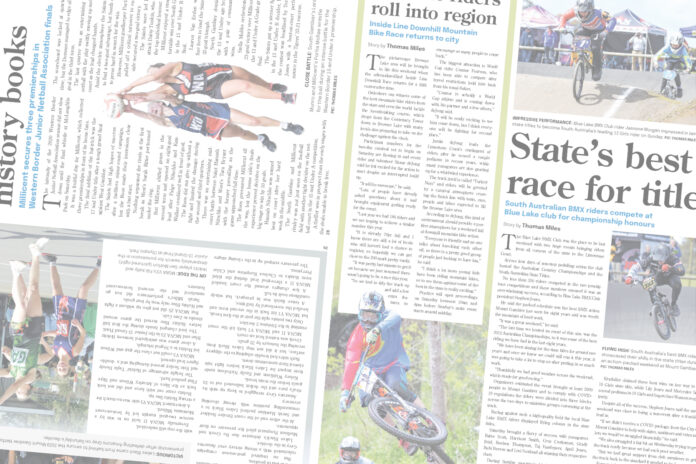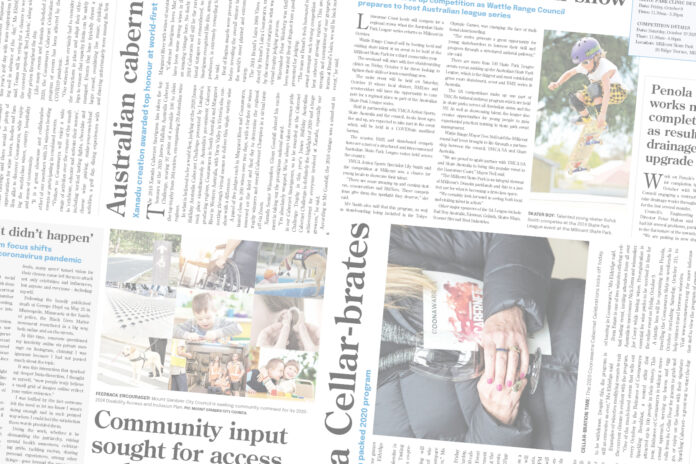Alot of questions have been circulating around my head on how to present this story.
First and foremost, I keep coming back to the question, why?
Why from the perspective of myself and why from the perspective of the CFS.
Why would I put myself in the face of danger rather than avoid it?
Why would the CFS allow media to step foot on any fireground rather than turn us away?
Our catch phrase at The SE Voice is ‘The local voice of your community’. I enjoy helping be that voice for those that want to know the story and for those that want to tell their story. I have the opportunity to gain access where others do not.
Being able to provide a first-hand account and retell from my perspective.
In this circumstance I understand it is risky. Why would I tempt that risk?
Delivering information to communities and highlighting the work of CFS volunteers can be risky and with this in mind the CFS regularly delivers bushfire safety training for media.
For that I am grateful. Through this training I have been better informed by those experienced in fighting fires to recognise a fire front and what equipment I need for the best possible protection and survival.
There is potential of being caught in a fire front due to a change in wind direction. We can take the necessary precautions, but sometimes an unexpected change can happen.
That’s what the training has taught us. In the event that was to happen, what we need to do to keep safe until the fire has passed and help arrives.
I have the opportunity to get close enough to report. I’m not going to knowingly tempt getting close enough to risk my life or the lives of the CFS volunteers.
I applaud the CFS volunteers who risk their lives. It’s incredibly brave.
I understand this training and accreditation does not mean we have free range to access firegrounds. There are still limitations as to what the CFS will allow.
If we are to access firegrounds we need to let the CFS know before we head out so those on the fireground are aware to expect us and our location at all times. We need to wear and carry appropriate Personal Protective Equipment (PPE).
The training is for our safety. The CFS are permitted to turn us away. Which is fair enough. At the end of the day, they are on the ground and experienced.
The last thing the CFS need is an unannounced interruption when they have an important and risky job at hand.
Ensuring media are armed with appropriate training and equipment is of importance to the CFS.
Though under the Fire and Emergency Services Act and Regulations it is the CFS responsibility to keep people in the area of a fire safe, I need to take responsibility for myself too.
Take on board what we have been taught and respect the privilege we have been given.
As for what we were taught, it was confronting, but necessary.
The video footage of firegrounds before, during and after a fire front was evidence they can wipe out everything in its path rapidly and the aftermath is devastating.
The video footage helped me understand the importance of deciding whether to stay or go. There is no time to procrastinate about making a decision.
The first-hand accounts provided by the CFS remind you there are people willing to risk being right in the thick of the fire. These people have lived it. They deserve to be applauded taking on a risk for the safety of the wider community.
At the end of the session there was a short theory-based assessment. Successful participants were issued with a CFS media accreditation card, valid for two years.
However, the card will not always guarantee access to a fireground. Access will be at the discretion of the CFS with safety remaining the priority.
We were made to understand the importance and responsibility of the accreditation.
If we are without the correct PPE, the CFS have the ability to remove us from the fireground and revoke our accreditation.
Though I do not yet have the PPE I’m keen to be well equipped so that I can carry out my job responsibly.
As for why would CFS provide training and accreditation to media. This was a question answered by CFS SA media and communications unit staff officer Brett Williamson who delivered the training.
“As part of the CFS being the organisation that controls responses to fires in rural areas, under the Fire and Emergency Services Act and Regulations, it is our responsibility to keep people in the area of a fire safe,” he said.
“With the media accessing firegrounds in circumstances where members of the general public are not allowed to, we present basic training to them with the basic knowledge of how to protect themselves and limit their exposure to harm.
“Without training, journalists may find themselves entering extremely dangerous areas and not being prepared for the conditions they would face or methods to use for survival.
“The primary reason that we conduct training across the state each year for media is to ensure they are safe, properly prepared and properly equipped when wanting to report on bushfires.
“Bushfires can be unpredictable and are one of the most dangerous places a media person would report from in Australia, so we want to make sure they are as safe as they can be when entering a fireground.”
The course was originally introduced in 2003. Mr Williamson said the course is reviewed and updated each year to reflect any changes.
“The training is reviewed on a regular basis and updated to suit any changes or noticeable trends,” he said.
“Following large fires, we take note of findings and investigations and make sure they are included in the latest round of training.
“With a prediction the 2019-2020 bushfire danger season was going to be one of the worst we would see in some time the course was reworked.”
Mr Williamson said there was more focus on the dangers of the approaching season and the mental health ramifications from the exposure to large fires.
He added mental health care has been a strong feature in the sessions.
“In the years following, particularly the Kangaroo Island and Cudlee Creek fires, we have open and honest conversations about the trauma that people will experience,” he said.
Mr Williamson highlighted where help can be sought to make sure people receive the appropriate care to recover from such events.
Offered to all media outlets, CFS staff travel across the state to ensure training is accessible to all.
Mr Williamson said more than 20 sessions are delivered across South Australia, from Mount Gambier to Port Lincoln and many places in between.
“Chief of staff and editors across the state recognise the worthiness of the training we provide and the importance of keeping their staff safe when they are covering bushfires,” he said.
“Without such accreditation media would not be provided access.”
Mr Williamson said almost every state rural fire service provides a fireground training course for media, tailored to their local situations and systems.
“Due to our accreditations lasting for two years, we have an ebb and flow for attendees,” he said.
“The CFS has more than 500 media contacts through the state and country.
“There is a regular turnover of staff in the media, so we often provide the training for people who have received it on a regular basis or for those who have recently moved into areas of bushfire risk.
“Last year I provided training for approximately 180 media staff.”




